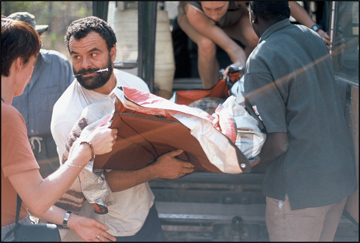An innovative group is using a venture capital model to save some of the world’s most endangered species, while at the same time working to ensure that local communities benefit from conservation efforts.
The Wildlife Conservation Network (WCN), an organization based in Los Altos, California, works to protect threatened species by focusing on what it terms “conservation entrepreneurs” — people who are passionate about saving wildlife and have creative ideas for dong so. After a rigorous review process to identify and select projects that will have the greatest impact on conservation in developing countries, WCN provides the conservationist with fund-raising and back-office support, technology, and access to its network of people and resources.
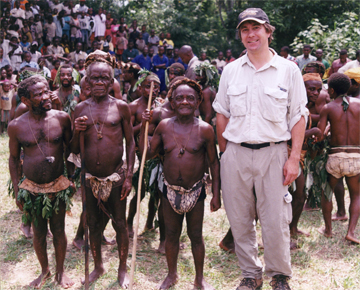
Charles Knowles with some of the Mbuti Pygmies who are on the staff of the Okapi Conservation Project in the DR Congo. © WCN |
“We look for very specific things,” said Charles Knowles, a retired Silicon Valley engineer who co-founded WCN in 2002. “The conservationist must live and work in the field, focus on a threatened species, engage in significant local community integration and involvement, and emphasize conservation action rather than solely research. We and our donors are interested in getting results which means saving species while sustaining local communities.”
The Silicon Valley model
WCN’s emphasis on network-building, identifying “mavericks” in conservation, and use of technology is an approach similar to that of the many venture capital firms in the area that have funded the likes of Yahoo, eBay, Google, and Cisco. The group runs lean with 93 percent of donations going to programs and encourages its partners — currently operating in 15 countries — to do so as well.
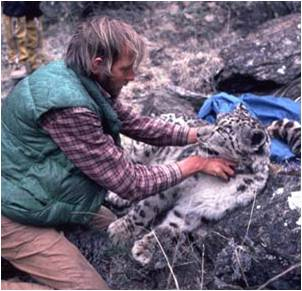
Dr. Rodney Jackson of the Snow Leopard Conservancy attaching a radio collar to a snow leopard. © Snow Leopard Conservancy |
“Like their counterparts in business, successful conservation entrepreneurs are creative, action-oriented and dare to try different strategies,” Knowles explained. “Their passion and commitment to wildlife preservation compels them to undertake conservation projects in areas the mainstream considers too risky or too challenging,”
“Hard-working, dedicated entrepreneurs know how to work on a shoestring,” he continued. “In addition, the costs of working in-country are low, and when the conservationists train local people to play important roles in conservation education and wildlife management, they make a valuable contribution to the local economy while ensuring that the conservation ethic becomes part of the community.”
Stacey Iverson, WCN Program Manager, says that Proyecto Titi in Colombia exemplifies the benefits that creative conservation strategies can bring to a community. The project focuses on the cotton-top tamarin, a charismatic, but endangered species of primate that is at risk from capture for the local pet trade, habitat loss, and plastic bags that accumulate in their forest habitat and become a health hazard for curious tamarins.
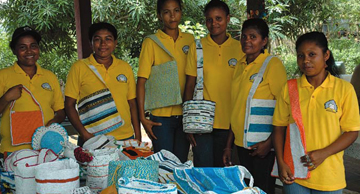
Six of the founding members of ASOARTESANAS proudly display their colorful eco-mochilas, © WCN Greg Rassmussen of Painted Dog Conservation doing a medical workup on an African wild dog. © Painted Dog Conservation |
“Proyecto Titi has developed a program which not only protects cotton-top tamarins and their rare habitat, but also turns the plastic trash into a valuable resource for local communities,” she said. “The program recruits women from local communities to create beautiful tote bags out of the plastic trash bags. Their Eco-mochila bag project has been a success in raising awareness, creating income and instilling pride in the communities. This tiny monkey has become an honored symbol in the many festivals and celebrations of the local communities.”
Eve Schaeffer, also a Program Manager at WCN, adds that a project in Zimbabwe, which turns wire snares into art, has paid similar dividends to local communities while raising the profile of one of the world’s most threatened canids.
“Painted Dog Conservation has turned a deadly threat to wildlife into a successful entrepreneurial venture for villagers,” she explained. “The group initiated Iganyana (the local word for painted dog) Arts to assist the local community in economic development by identifying, encouraging and training talented individuals to create arts and crafts for the national and international market. The basic material for these crafts is snare wire, which is sculpted into impressive wire animals that sell for hundreds of dollars.”
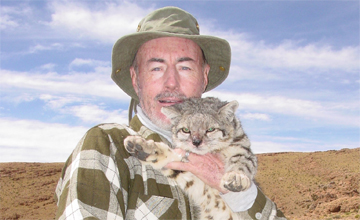
Often overlooked, small wild cats are important and in trouble: An interview with small cat specialist Dr. Jim Sanderson Dr Jim Sanderson, a scientist with the Small Cat Conservation Alliance and Conservation International, is working to save some of the world’s rarest cats, including the Andean cat and Guigna of South America and the bay, flat-headed, and marbled cats of Southeast Asia. |
WCN also takes the venture capital approach when it comes to marketing and fund-raising, using “road-shows” to allow conservationists to interact directly with supporters and potential donors. For example, in August Jim Sanderson of the Small Cat Alliance pitched his efforts to protect the world’s most endangered small cats directly to a passionate audience at a recent gathering in Los Altos. The event raised over seventy thousand dollars for Jim’s work.
On a larger scale, donors also have a chance to meet and speak directly with field scientists at WCN’s annual Wildlife Conservation Expo each October. This year’s event, which takes place in San Francisco on October 4th, features 18 leading conservationists from around the world, including experts on elephants, tigers, cheetahs, gorillas, and other highly endangered species.
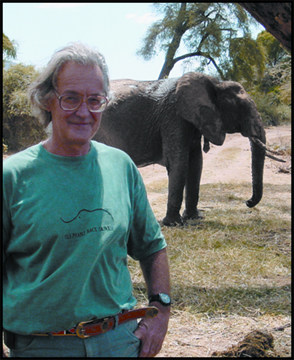
Iain Douglas-Hamilton of Save the Elephants © Save the Elephants |
“Wildlife enthusiasts really enjoy this event because they can meet, in person, the scientists they see on TV and read about in magazines.” said Akiko Yamazaki, WCN co-founder, who added that donors also appreciate being able to designate how their money is used.
“Whether it’s for protecting the okapi in the Democratic Republic of Congo, conserving the maned wolf of South America, or helping tigers in Siberia, 100 percent of any donation can be designated to the conservation of a specific species,” she added.
Bill Miller, a life-long entrepreneur and former Vice President and Provost of Stanford University, agreed.
“The personal connection with conservationists in the field helps donors see that funds are being used effectively.”
Venture connections spawn other benefits for local communities
Beyond financial contributions, conservationists benefit from WCN’s association with the entrepreneurs of Silicon Valley. At the 2003 WCN Expo, Rebecca Klein of Cheetah Conservation Botswana mentioned the challenge presented by a lack of electricity in her study area. Hearing this, Stephen Gold, a proponent of solar energy, recruited $350,000-worth of donations in solar equipment and eventually set up solar systems to power projects in Kenya, Zimbabwe, Ethiopia, and Botswana. Researchers now power their computers using the sun rather than noisy and polluting diesel generators, while staff members and their families have electricity. Another WCN relationship has enabled the group to offer HIV-AIDS testing, counseling, and treatment in areas where such services are not available. Still another program has established scholarships for students in local communities who represent the future of conservation.
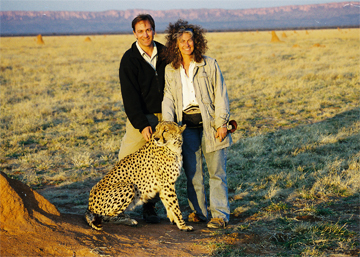
Charles Knowles with Dr. Laurie Marker of Cheetah Conservation Fund in Namibia. © WCN |
“These conservation pioneers will lead efforts to create sustainable futures for imperiled species in some of our planet’s most remote and endangered regions,” said Knowles. “The scholarship provides grants for graduate education and applied training to promising community-based conservationists. It supports local people working within their communities to develop a long-range conservation ethic. Recipients are empowered to develop cooperative and innovative solutions to promote co-existence between humans and wildlife.”
The WCN Expo takes place on October 4th at the Mission Bay Conference Center in San Francisco.
Speaker Schedule
Speaker schedule subject to change
Mission Bay Conference Center
| Robertson Auditorium | Fisher Banquet Room | |
| 10:00am – 10:30am | Dr. Rodney Jackson Snow Leopard Conservancy |
Dr. Robert Williams Association for the Conservation of Otters of the Peruvian Amazon |
| 10:45am – 11:15am | Elena Bykova Saiga Conservation Alliance |
Siew Te Wong Bornean Sun Bear Conservation |
| 11:30am – 12:00pm | Greg Rasmussen and Peter Blinston Painted Dog Conservation |
Dr. Dale Miquelle Wildlife Conservation Society (Amur tiger and leopard) |
| 12:00pm – 1:00pm | Lunch Break (A $15 boxed lunch will be available for purchase) |
|
| 1:00pm – 1:30pm | Dr. Claudio Sillero Ethiopian Wolf Conservation Program |
Colleen Begg Niassa Carnivore Project (Lion) |
| 1:45pm – 2:15pm | Dr. Iain Douglas-Hamilton Save the Elephants |
Dr. Mauro Lucherini Andean Cat Alliance |
| 2:30pm – 3:00pm | Rebecca Klein Cheetah Conservation Botswana |
Rogerio Cunha de Paula ProCarnivoros (Maned wolf) |
| 3:15pm – 3:45pm | Rosamira Guillen Proyecto Titi (Cotton-top tamarin) |
Dr. James Sanderson Small Cat Conservation Alliance |
| 4:00pm – 4:30pm | Megan Parker Working Dogs for Conservation |
Dr. Alecia Lilly The Dian Fossey Gorilla Fund International |
| 4:45pm – 5:15pm | Dr. Laurie Marker Cheetah Conservation Fund |
|
